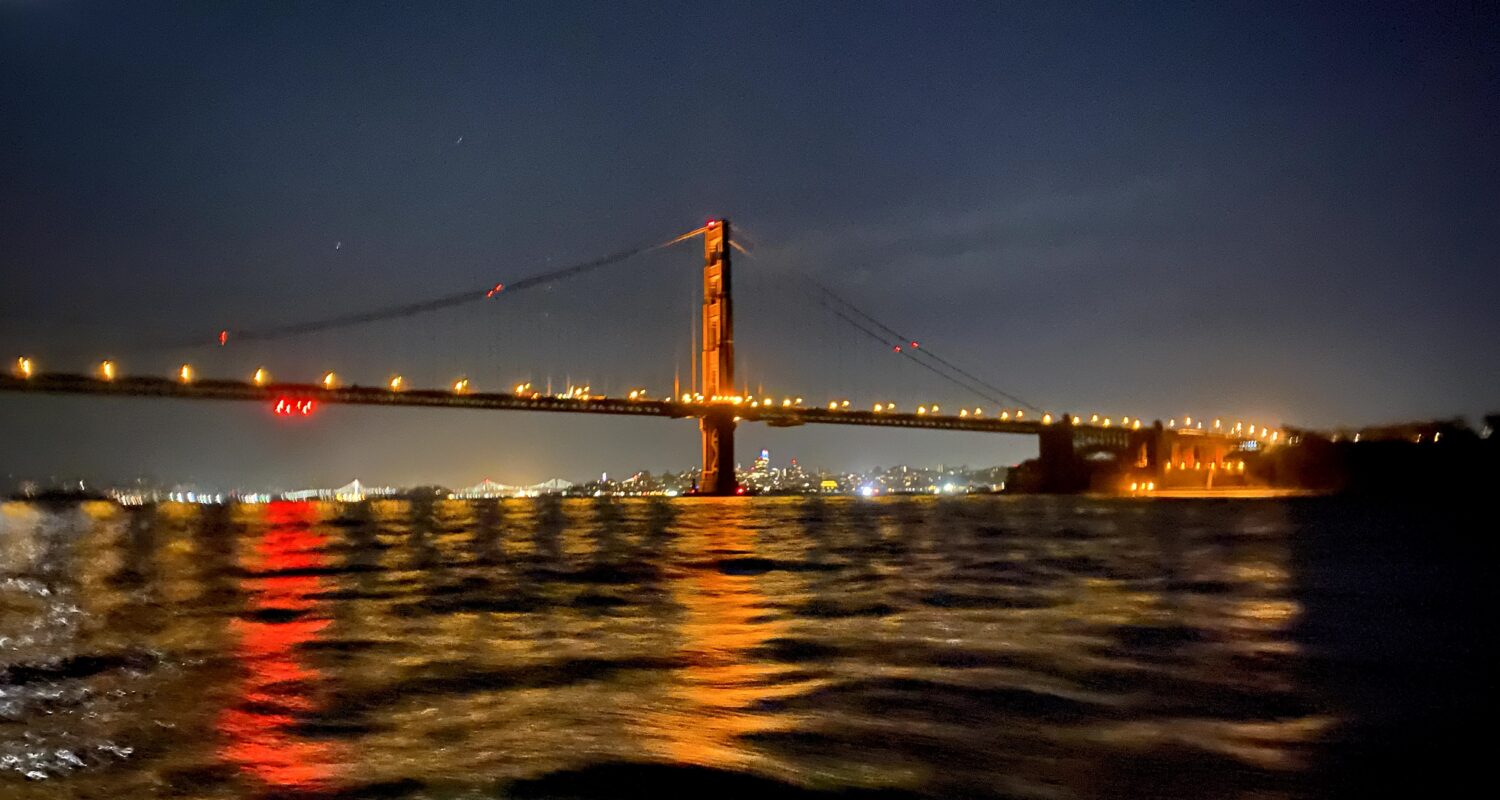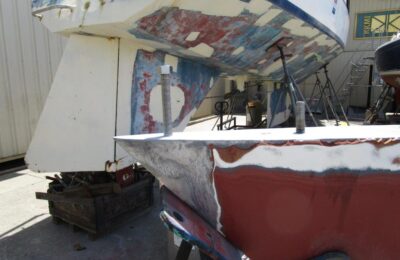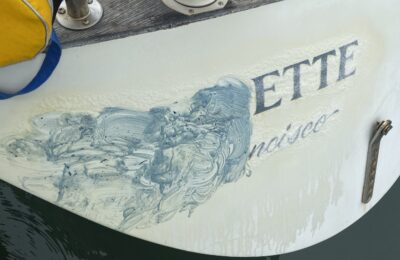There are many sailing skills I have yet to develop, and not the least of them is a portfolio of experience sailing overnight, as well as cooking while under way. Having a go at both seemed like a good idea in anticipation of more ambitious trips in the future. I invited a friend with similar sailing-skill-building ambitions to go along and was very pleased that he agreed to do so.
The Plan
The idea was to do a 24 hour sail: 12 hours out and approximately 12 hours back. Enough time to go through the night and to take turns with watches. Try to cook some food on a swinging stove in the galley. We put a date on the calendar a few weeks out and made some plans. Wrapping up small projects here and there on the boat.
As we approached the departure, Bryan suggested that we strongly consider having a good “what if the boat sinks” plan B. Last year I purchased the smallest 3 person dinghy sold at West Marine, a model called the PR-3. I haven’t kept it on the boat – it takes up quite a bit of room, even deflated, but this trip was a good excuse to see if we could lash it to the foredeck for emergency purposes. We also had the fixed VHF radio on the boat, a hand-held VHF, a couple of cell phones, and a float EPIRB. If we really had to get in the dinghy in extremis, we could have sent out data on our whereabouts in several formats.
Ahead of our trip, the weather report was interesting. The first proper Alaskan swell of the season was moving down the coastline with wave heights forecast as high as 10-15 feet. The wind was a mixed bag, building to the low 20’s in the afternoon outside of the Golden Gate, and continuing to grow after sundown. We looked at Windy.com and Predictwind.com. Our allotted two days would not be a cakewalk.
The Trip
On the way to the marina, I saw a double-ender rainbow outside the bridge and called it a good omen. This is from Lincoln Avenue on the North side of San Francisco.
Arriving at the boat, I was able to slide the little dinghy into place on the foredeck by myself, without rigging any halyard hoist. It’s just small enough and light enough for me to manhandle around.
One downside of this placement is that the dinghy covers both operable hatches at the front of the 32-200. It would not be a good choice for a slow, hot, tropical day.
Safety lines rigged, food stowed, off we went, right around 10am. The day was gray and breezy. We tacked back and forth out of the slot under the Golden Gate.
The jib sheets were catching occasionally on the back of the dinghy tubes on the foredeck. Bryan went forward and rigged a diagonal line from the whisker pole ring to the dinghy lashing to keep the jib sheets off.
The Aries Wind Vane steered. I had moved my first set of turning blocks to try to address some chafing. This worked, but it won’t be the final implementation. I think I will wind up with an extra stanchion post bolted on to the pushpit instead of a lashing solution.
Bryan had brought along some cold sandwiches for lunch from a nearby grocery store, and I ate one with relish around noon. We were under way and headed west into the void.
The wind dissipated for a time and we pointed west with the motor. The Yanmar obeyed eagerly and I didn’t mind running for an hour or so, as my battery charger died a few months back and supply-chain issues are delaying the delivery of a replacement from Defender. This topped up the batteries for the planned all-night run with lights on.
In the afternoon I went below to change out of my casual sailing attire and into proper foul weather gear as evening approached. The sea state was not terribly bad at this point, but the churning below as I changed costumes led to the mal de mer. I emerged from the companionway barely in time to spew a partially-digested salami sandwich across the leeward edge of the boat. Good times. Had I not made it to the exit, it would have been truly unpleasant down below.
The weather grew colder and the swell rose gradually. Here is Bryan enjoying the “balmy” afternoon:
The sun had been obscured by cloud cover all day, but at sunset, dipped into clarity at the horizon line and treated us to a warm light display. It was a welcome vision after a long beating into the wind.
This was around the time the weather prediction sites suggested the swell would build with intensity.
Everyone reads and thinks about safety in the open ocean and the importance of being tethered to a boat. What I can affirm is that after sundown, the sea indeed turns into a vast void of frightening nothingness. I’m stating it strongly of course, but thinking about a man-overboard situation in the middle of the night in the open ocean with a swell, is an entirely different kettle-of-fish than a man-overboard in the daytime, with reasonable visibility etc.
The darkness arrived suddenly and with our timing, so did the swell. The periodicity of the wavelengths was reasonably long (forecast at 13 seconds) so we were riding up and then down, and not bashing forward and back. We continued west another 30 minutes or so.
The plan we discussed setting out was to split watches 10-2am and 2-6am. After puking I was feeling rather miserable, and with the loss of the horizon sightline in the darkness, the situation was not improving. I wanted to take the 10am-2pm shift, but was feeling a combination of exhaustion/sea-sickness/cold that I didn’t think I could be a safe hand to keep an eye on things. At this point we were North of the Farallones, about as far out as the islands.
It was a form of chickening out, but I declared we should turn tail and head home. The swell was building and I felt pretty miserable. Bryan pressed pause for a moment and we talked about the decision. He assented, but probably could have kept going for longer than I wanted to.
So we reversed course and headed back toward the city. All of a sudden being twenty five miles outside of the Golden Gate felt like a comfortable neighborhood. We could see the lights of the city ahead, the light at Point Reyes off the port side and the Farallones light off starboard.
It was a broad reach with a following sea. The vane steered well enough for some time.
I made one last try to go below and rest at ten o’clock. I sat at the companionway entry and took a look at the lights around the boat. I closed my eyes, and with a small barf-bucket in hand, made my way in voluntary blindness down into the quarterberth. I wanted a 30 minute nap. I made it there, stripped off the wet foulies, pulled on a warmer layer of long underwear and set my alarm for 30 minutes. I remember the sound of the water rushing by. Then the alarm.
Back on deck, I felt a million times better. I had managed to have a brief rest and felt quite rejuvenated. We continued East, back toward the Golden Gate. Eventually the course steered by the wind vane wandered excessively. The vane always recovered the intended direction, but the angle of the flapper blade to the wind oscillated as we rode up and down the swells, and there were some pronounced S-turns.
After we passed Point Bonita, our course was protected from the main swell and much of the wind. We slowed, eventually turning on the engine.
The bridge shimmered quietly under the stars when we passed under at 1:15am.
Motoring around the corner to Sausalito and my home marina, the route felt unfamiliar and somewhat perilous for lack of lighted markers. I nearly drove us into the mud on the East side of the Richardson Bay channel.
Back and snugged into Sure Shot’s berth around 2:30am.
Lessons Learned
Having a good teammate/partner helps immensely. Bryan has a bit more sailing under his belt than I do, and I have yet to see him rattled even steering amongst the inexperienced and bull headed racers at the Richmond Yacht Club beer can races.
The little West Marine dinghy was nice to have on deck at the ready. In urgent circumstances we would have cut off the lashed ropes.
With our AIS transponder on, Sure Shot location was visible on MarineTraffic.com for passive monitoring. This was fun for my wife to be able to show my boys as we sailed out and back.
Warm cockpit clothing should be like reefing sails – implemented before actually being needed. That seasickness would make going below mentally exhausting was not something I had anticipated. Sitting in a cold wet cockpit in cold wet clothes isn’t terribly fun.
No cooking took place on this trip. Bryan had set himself in charge of food and with the oscillating boat and the general queasiness, there was no way he wanted to go below and have a go with a swinging propane stove. I blame him not a bit. I think a lesson is to plan for the simplest of simple meals for several days into a long trip. A box or package of digestible food that can be opened and consumed immediately. The box of grocery store chocolate chip cookies was a nice energy kick after my nap. More like that.
To stave off seasickness, I used an acupressure band and some organic oil that made me smell like a Berkeley crystal shop. I’m not sure if either one made much of a difference. Dramamine is an obvious possibility, but I find that I am in the group of people for whom “May Cause Drowsiness” warnings nearly always apply. I remember a miserable day as an adolescent of offshore fishing out of San Diego with my father. Waking up only enough to puke several times.
The mal de mer + exhaustion seems to be the most daunting part for me. The boat worked fine. The seas were big but not ever really scary. We didn’t get through the 24 hour goal, but learned a lot nevertheless.



